
The Oceanian realm is one of the World Wildlife Fund (WWF) biogeographic realms, and is unique in not including any continental land mass. It has the smallest land area of any of the WWF realms.
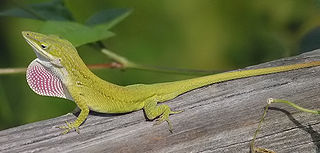
Dactyloidae are a family of lizards commonly known as anoles and native to warmer parts of the Americas, ranging from southeastern United States to Paraguay. Instead of treating it as a family, some authorities prefer to treat it as a subfamily, Dactyloidae, of the family Iguanidae. In the past they were included in the family Polychrotidae together with Polychrus, but the latter genus is not closely related to the true anoles.

Skinks are lizards belonging to the family Scincidae, a family in the infraorder Scincomorpha. With more than 1,500 described species across 100 different taxonomic genera, the family Scincidae is one of the most diverse families of lizards. Skinks are characterized by their smaller legs in comparison to typical lizards and are found in different habitats except arctic and subarctic regions.

The Bermuda skink, longnose skink, or Bermuda rock lizard is a critically endangered species and the only endemic land-living vertebrate of Bermuda. It is a relatively small skink : adults reach an average snout-to-vent length of about 8 cm (3.1 in).
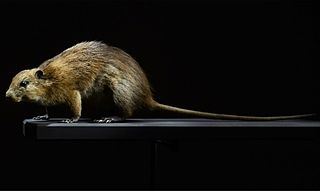
Megalomys desmarestii, also known as the Martinique muskrat, Desmarest's pilorie, or the Martinique giant rice rat, is an extinct rice rat from Martinique in the Caribbean.

Tiliqua rugosa, most commonly known as the shingleback skink or bobtail lizard, is a short-tailed, slow-moving species of blue-tongued skink endemic to Australia. It is commonly known as the shingleback or sleepy lizard. Three of its four recognised subspecies are found in Western Australia, where the bobtail name is most frequently used. The fourth subspecies, T. rugosa asper, is the only one native to eastern Australia, where it goes by the common name of the eastern shingleback.
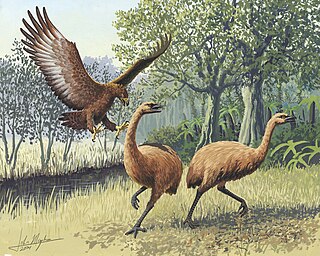
Island gigantism, or insular gigantism, is a biological phenomenon in which the size of an animal species isolated on an island increases dramatically in comparison to its mainland relatives. Island gigantism is one aspect of the more general "island effect" or "Foster's rule", which posits that when mainland animals colonize islands, small species tend to evolve larger bodies, and large species tend to evolve smaller bodies. This is itself one aspect of the more general phenomenon of island syndrome which describes the differences in morphology, ecology, physiology and behaviour of insular species compared to their continental counterparts. Following the arrival of humans and associated introduced predators, many giant as well as other island endemics have become extinct. A similar size increase, as well as increased woodiness, has been observed in some insular plants.
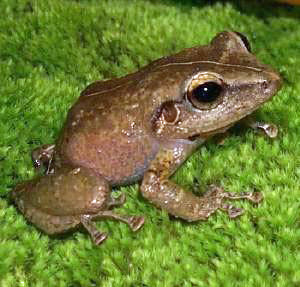
The fauna of Puerto Rico is similar to other island archipelago faunas, with high endemism, and low, skewed taxonomic diversity. Bats are the only extant native terrestrial mammals in Puerto Rico. All other terrestrial mammals in the area were introduced by humans, and include species such as cats, goats, sheep, the small Indian mongoose, and escaped monkeys. Marine mammals include dolphins, manatees, and whales. Of the 349 bird species, about 120 breed in the archipelago, and 47.5% are accidental or rare.
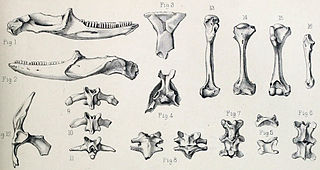
The Mauritian giant skink is a large, extinct species of skink It was found only in Mauritius. It became extinct around 1600, probably due to human-introduced predators.

The terror skink, also called commonly Bocourt's terrific skink, Bocourt's eyelid skink and Bocourt's skink, is a species of lizard in the family Scincidae. The species is endemic to the Île des Pins, a small islet off the coast of New Caledonia. First described in 1876, the species was presumed to be extinct, but was rediscovered in 1993, and since then several individuals have been seen. Because of its small area of occupation and small population size, the International Union for Conservation of Nature has assessed its conservation status as being "critically endangered".
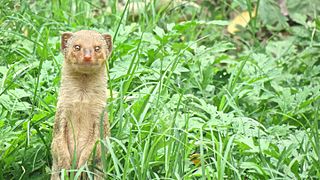
The small Indian mongoose is a mongoose species native to Iraq and northern South Asia; it has also been introduced to many regions of the world, such as several Caribbean and Pacific islands.
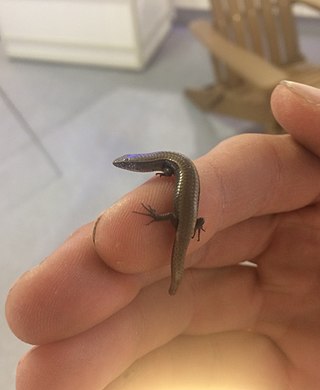
Spondylurus is a genus of lizards in the family Scincidae. The genus Spondylurus, vernacularly known as the Antillean four-lined skinks, is a neotropical skink taxon including many species.
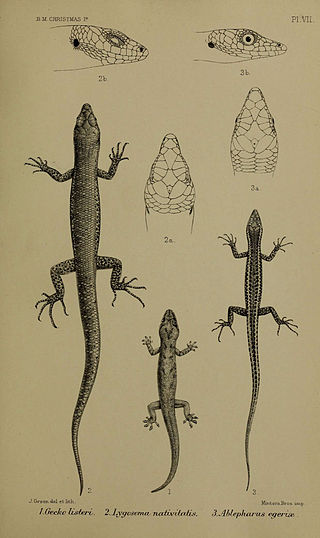
Cryptoblepharus egeriae, also known commonly as the blue-tailed shinning-skink, the Christmas Island blue-tailed shinning-skink, and the Christmas Island blue-tailed skink, is a species of lizard in the family Scincidae that was once endemic to Christmas Island. The Christmas Island blue-tailed skink was discovered in 1888. It was formerly the most abundant reptile on the island, and occurred in high numbers particularly near the human settlement. However, the Christmas Island blue-tailed skink began to decline sharply outwardly from the human settlement by the early 1990s, which coincided with the introduction of a predatory snake and the introduction of the yellow crazy ant in the mid-1980s. By 2006, the Christmas Island blue-tailed skink was on the endangered animals list, and by 2010 the Christmas Island blue-tailed skink was extinct in the wild. From 2009-2010, Parks Australia and Taronga Zoo started a captive breeding program, which has prevented total extinction of the species.
Alinea is a genus of skinks endemic to the Lesser Antilles. This genus may be extinct, as one species, A. luciae, is considered extinct by the IUCN Red List, while the other, A. lanceolata, is also feared extinct due to the lack of recent sightings, although potential refuges may exist. However, there is some controversy over whether Alinea is a separate genus or synonymous with Mabuya. If it is distinct, introduced predators like the Javan mongoose may have contributed to this genus's extinction.

Mabuyinae is a subfamily of skinks within the family Scincidae. The genera in this subfamily were previously found to belong the Mabuya group in the large subfamily Lygosominae.
The Culebra skink is a species of skink found on Culebra and on Culebrita, an uninhabited island off Culebra, in Puerto Rico.
The greater Saint Croix skink is a species of skink found on Saint Croix in the United States Virgin Islands.
The Lesser Virgin Islands skink is a species of skink found in the United States Virgin Islands and the British Virgin Islands.
Spondylurus sloanii, also known commonly as Sloane's skink or the Virgin Islands bronze skink, is a species of lizard in the family Scincidae. The species is native to the United States Virgin Islands and the British Virgin Islands.















